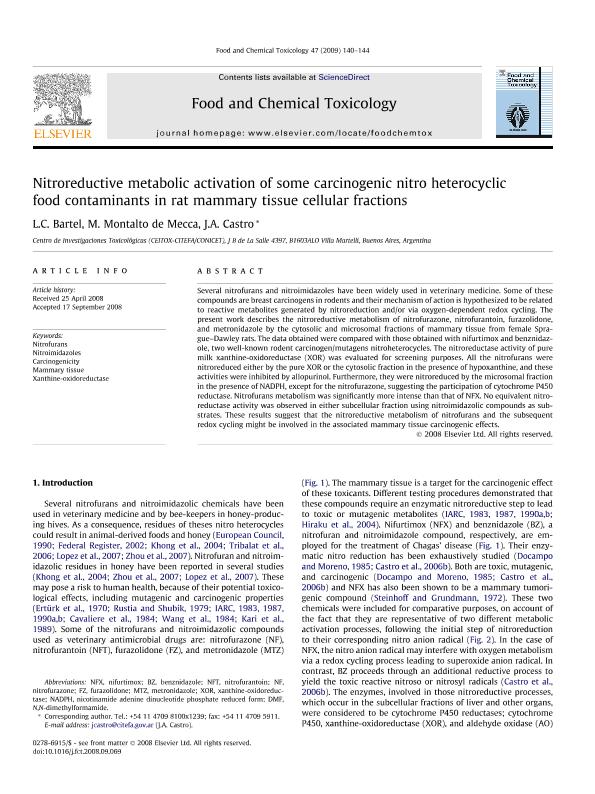Mostrar el registro sencillo del ítem
dc.contributor.author
Bartel, Laura Cecilia

dc.contributor.author
Montalto, Maria

dc.contributor.author
Castro, Jose Alberto

dc.date.available
2019-08-26T18:16:33Z
dc.date.issued
2009-01
dc.identifier.citation
Bartel, Laura Cecilia; Montalto, Maria; Castro, Jose Alberto; Nitroreductive metabolic activation of some carcinogenic nitro heterocyclic food contaminants in rat mammary tissue cellular fractions; Pergamon-Elsevier Science Ltd; Food And Chemical Toxicology; 47; 1; 1-2009; 140-144
dc.identifier.issn
0278-6915
dc.identifier.uri
http://hdl.handle.net/11336/82109
dc.description.abstract
Several nitrofurans and nitroimidazoles have been widely used in veterinary medicine. Some of these compounds are breast carcinogens in rodents and their mechanism of action is hypothesized to be related to reactive metabolites generated by nitroreduction and/or via oxygen-dependent redox cycling. The present work describes the nitroreductive metabolism of nitrofurazone, nitrofurantoin, furazolidone, and metronidazole by the cytosolic and microsomal fractions of mammary tissue from female Sprague-Dawley rats. The data obtained were compared with those obtained with nifurtimox and benznidazole, two well-known rodent carcinogen/mutagens nitroheterocycles. The nitroreductase activity of pure milk xanthine-oxidoreductase (XOR) was evaluated for screening purposes. All the nitrofurans were nitroreduced either by the pure XOR or the cytosolic fraction in the presence of hypoxanthine, and these activities were inhibited by allopurinol. Furthermore, they were nitroreduced by the microsomal fraction in the presence of NADPH, except for the nitrofurazone, suggesting the participation of cytochrome P450 reductase. Nitrofurans metabolism was significantly more intense than that of NFX. No equivalent nitroreductase activity was observed in either subcellular fraction using nitroimidazolic compounds as substrates. These results suggest that the nitroreductive metabolism of nitrofurans and the subsequent redox cycling might be involved in the associated mammary tissue carcinogenic effects.
dc.format
application/pdf
dc.language.iso
eng
dc.publisher
Pergamon-Elsevier Science Ltd

dc.rights
info:eu-repo/semantics/openAccess
dc.rights.uri
https://creativecommons.org/licenses/by-nc-sa/2.5/ar/
dc.subject
Carcinogenicity
dc.subject
Mammary Tissue
dc.subject
Nitrofurans
dc.subject
Nitroimidazoles
dc.subject
Xanthine-Oxidoreductase
dc.subject.classification
Toxicología

dc.subject.classification
Medicina Básica

dc.subject.classification
CIENCIAS MÉDICAS Y DE LA SALUD

dc.title
Nitroreductive metabolic activation of some carcinogenic nitro heterocyclic food contaminants in rat mammary tissue cellular fractions
dc.type
info:eu-repo/semantics/article
dc.type
info:ar-repo/semantics/artículo
dc.type
info:eu-repo/semantics/publishedVersion
dc.date.updated
2019-08-22T13:21:11Z
dc.journal.volume
47
dc.journal.number
1
dc.journal.pagination
140-144
dc.journal.pais
Países Bajos

dc.journal.ciudad
Amsterdam
dc.description.fil
Fil: Bartel, Laura Cecilia. Consejo Nacional de Investigaciones Científicas y Técnicas. GP. CITEFA - Centro de Investigaciones Toxicológicas (I); Argentina
dc.description.fil
Fil: Montalto, Maria. Consejo Nacional de Investigaciones Científicas y Técnicas. GP. CITEFA - Centro de Investigaciones Toxicológicas (I); Argentina
dc.description.fil
Fil: Castro, Jose Alberto. Consejo Nacional de Investigaciones Científicas y Técnicas. GP. CITEFA - Centro de Investigaciones Toxicológicas (I); Argentina
dc.journal.title
Food And Chemical Toxicology

dc.relation.alternativeid
info:eu-repo/semantics/altIdentifier/url/https://www.sciencedirect.com/science/article/pii/S0278691508006091
dc.relation.alternativeid
info:eu-repo/semantics/altIdentifier/doi/https://doi.org/10.1016/j.fct.2008.09.069
Archivos asociados
